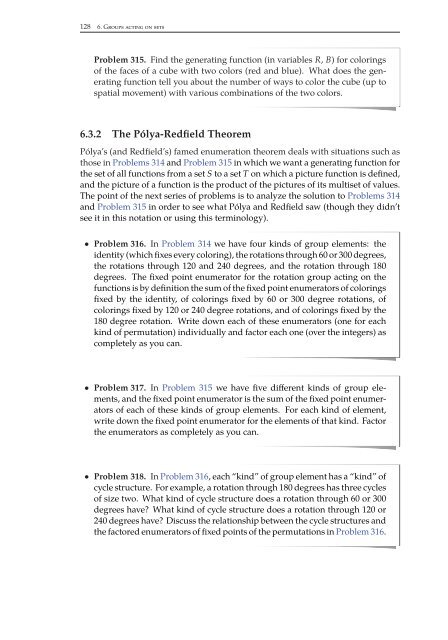Combinatorics Through Guided Discovery, 2004a
Combinatorics Through Guided Discovery, 2004a
Combinatorics Through Guided Discovery, 2004a
Create successful ePaper yourself
Turn your PDF publications into a flip-book with our unique Google optimized e-Paper software.
128 6. Groups acting on sets<br />
Problem 315. Find the generating function (in variables R, B) for colorings<br />
of the faces of a cube with two colors (red and blue). What does the generating<br />
function tell you about the number of ways to color the cube (up to<br />
spatial movement) with various combinations of the two colors.<br />
6.3.2 The Pólya-Redfield Theorem<br />
Pólya’s (and Redfield’s) famed enumeration theorem deals with situations such as<br />
those in Problems 314 and Problem 315 in which we want a generating function for<br />
the set of all functions from a set S to a set T on which a picture function is defined,<br />
and the picture of a function is the product of the pictures of its multiset of values.<br />
The point of the next series of problems is to analyze the solution to Problems 314<br />
and Problem 315 in order to see what Pólya and Redfield saw (though they didn’t<br />
see it in this notation or using this terminology).<br />
• Problem 316. In Problem 314 we have four kinds of group elements: the<br />
identity (which fixes every coloring), the rotations through 60 or 300 degrees,<br />
the rotations through 120 and 240 degrees, and the rotation through 180<br />
degrees. The fixed point enumerator for the rotation group acting on the<br />
functions is by definition the sum of the fixed point enumerators of colorings<br />
fixed by the identity, of colorings fixed by 60 or 300 degree rotations, of<br />
colorings fixed by 120 or 240 degree rotations, and of colorings fixed by the<br />
180 degree rotation. Write down each of these enumerators (one for each<br />
kind of permutation) individually and factor each one (over the integers) as<br />
completely as you can.<br />
• Problem 317. In Problem 315 we have five different kinds of group elements,<br />
and the fixed point enumerator is the sum of the fixed point enumerators<br />
of each of these kinds of group elements. For each kind of element,<br />
write down the fixed point enumerator for the elements of that kind. Factor<br />
the enumerators as completely as you can.<br />
Problem 318.<br />
• In Problem 316, each “kind” of group element has a “kind” of<br />
cycle structure. For example, a rotation through 180 degrees has three cycles<br />
of size two. What kind of cycle structure does a rotation through 60 or 300<br />
degrees have? What kind of cycle structure does a rotation through 120 or<br />
240 degrees have? Discuss the relationship between the cycle structures and<br />
the factored enumerators of fixed points of the permutations in Problem 316.


















